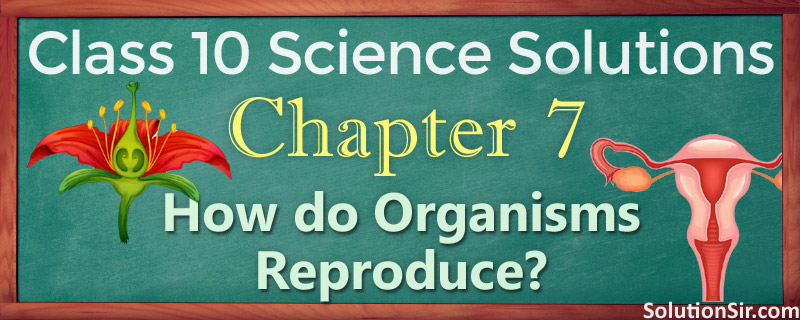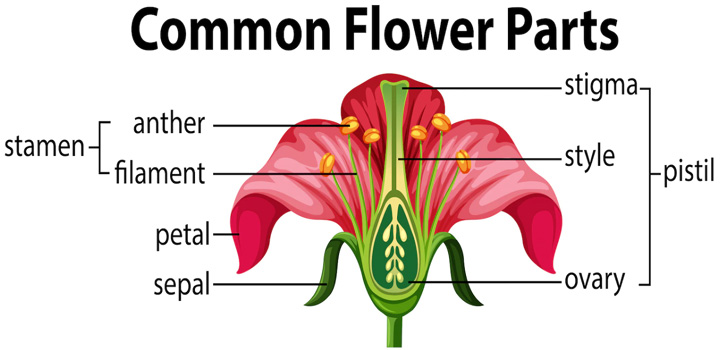Find the Best NCERT Solutions for Class 10 Science Chapter 7 on our website with all the questions and answers especially written for class 10 students. You will know about Ch 7 How do Organisms Reproduce, learn its concepts, and get important tips 🔥 on how to write (1) precise answers (2) without using unnecessary words (3) within ideal length. You will access all of this information for FREE in addition to class 10 science NCERT solutions chapter 7.
Ch 7 – How do Organisms Reproduce?

Use this link — 🌐 10.solutionsir.com for any kind of help in 10th class 2023-24. Click Here for » All Chapters: NCERT Solutions for Class 10 Science.
NCERT Solutions for Class 10 Science Chapter 7 Exercise – We notice organisms because they reproduce and more importantly, it is the large numbers of organisms belonging to a single species that bring them to our notice. Now, ⚡ in the seventh chapter “How do Organisms Reproduce?” (Chapter 7 Science Class 10), we will examine how different organisms actually reproduce. We will also know that the modes by which various organisms reproduce depend on the body design of the organisms.
Chapter 7 How do Organisms Reproduce? – Important Points: Reproduction involves creation of a DNA copy and additional cellular apparatus by the cell involved in the process. Various organisms use different modes of reproduction depending on their body design. Sexual reproduction involves two individuals for the creation of a new individual while it is not necessary to have two parents to produce offspring in asexual reproduction.
Special Note: 👉 Click the “Prepare” button to know, how to prepare How do Organisms Reproduce chapter for exams. Get more helpful information, watch explanation videos and pay attention to handwritten version of our answer to score 💯 good marks in class 10 Science NCERT solutions Chapter 7. You will get everything that you need to prepare a question thoroughly.
NCERT Solutions for Class 10 Science Chapter 7
Table of Contents
Page 114
EX 1 – Chapter no 7 – Page 114 Solutions
Question 1: What is the importance of DNA copying in reproduction?
Answer: DNA carries genetic information from one generation to the other and this helps in producing organisms of its own types. DNA copying is a must for inheriting the traits from parents. Any variations in DNA copying will give rise to the origin of new species.
Question 2: Why is variation beneficial to the species but not necessarily for the individual?
Answer: The reason why the variation is beneficial to the species rather than individuals is because sometimes the climatic changes have a drastic effect on the species, which makes their survival difficult. For example, if the temperature of the water body increases, then there might be certain species of microorganisms which might die. This may result in disturbance in the environment. So, variation is beneficial to species and not for the individuals.
End of Page no 114 solutions – In text exercise 1 – chapter number 7 intext questions. NCERT Solutions for Class 10 Science Chapter 7.
Page 119
EX 2 – Chapter no 7 – Page 119 Solutions
Question 1: How does binary fission differ from multiple fission?
Answer: In binary fission a single cell divides into two equal halves. Amoeba and bacteria divide by binary fission. In multiple fission, a single cell divides into many daughter cells simultaneously. Plasmodium divides by multiple fission.
Question 2: How will an organism be benefited if it reproduces through spores?
Answer: An organism is benefited by reproducing through the spores because spores are surrounded by a thick layer which protects them in adverse conditions. When favourable conditions occur, these spores start to grow again.
Question 3: Can you think of reasons why more complex organisms cannot give rise to new individuals through regeneration?
Answer: Organisms at higher complex levels cannot give rise to new individuals through regeneration because they have organization of their organs system at different levels. All these organ systems are interconnected and work in full coordination. They can regenerate a few of their lost body parts like skin, blood, muscles, etc. but can’t give rise to new individuals.
Question 4: Why is vegetative propagation practised for growing some types of plants?
Answer: Vegetative propagation is practiced for growing some types of plants because –
(i) It is used to grow a plant in which viable seeds are not formed.
(ii) It helps to introduce plants in new areas where the seed germination fails to produce mature plants.
(iii) A good quality of a race or variety can be preserved by the method of vegetative propagation.
Question 5: Why is DNA copying an essential part of the process of reproduction?
Answer: DNA copying is an essential part of the process of reproduction because it carries the genetic information from the parents to offspring. A copy of DNA is produced through some chemical reactions resulting in two copies of DNA. Along with the additional cellular structure, DNA copying also takes place which is then followed by cell division into two cells.
End of Page no 119 solutions – In text exercise 2 – chapter number 7 intext questions. NCERT Solutions for Class 10 Science Chapter 7.
Page 126
EX 3 – Chapter no 7 – Page 126 Solutions
Question 1: How is the process of pollination different from fertilisation?
Answer: Pollination is the process of transfer of pollens from anther to stigma. It occurs with the help of certain pollinators such as air, water, birds, or some insects. Fertilization is the fusion of the male and female gametes. It occurs inside the ovule and leads to the formation of zygote.
Question 2: What is the role of the seminal vesicles and the prostate gland?
Answer: Seminal vesicle and prostate gland secretes fluids which form a part of the semen. The fluid makes the path smooth through which the sperms travel. This fluid protects the sperms from the acids present in the urethra. and provides nutrition to sperms in the form of fructose, calcium and some enzymes.
Question 3: What are the changes seen in girls at the time of puberty?
Answer: The changes seen in girls at the time of puberty are –
(i) Increase in breast size and darkening of skin of the nipples present at the tips of the breasts.
(ii) Appearance of hair in the genital area.
(iii) Appearance of hair in other areas of skin like underarms, face, hands, and legs.
(iv) Increase in the size of uterus and ovary.
(v) Beginning of menstrual cycle.
(vi) More secretion of oil from the skin, which results in the appearance of pimples.
Question 4: How does the embryo get nourishment inside the mother’s body?
Answer: After fertilization the lining of the uterus thickens and is richly supplied with blood to nourish the growing embryo. The embryo gets nutrition from the mother’s blood with the help of a special tissue called placenta. It is embedded in the uterine wall. Placenta contains Villi on the embryo’s side of the tissue and blood spaces on mother’s side surrounding the villi. This provides a large surface from mother to the embryo and waste products from embryo to mother.
Question 5: If a woman is using a copper-T, will it help in protecting her from sexually transmitted diseases?
Answer: Copper-T is a contraceptive method which prevents implantation of the zygote inside the uterus. It cannot prevent a woman from sexually transmitted diseases.
End of Page no 126 solutions – In text exercise 3 – chapter number 7 intext questions. NCERT Solutions for Class 10 Science Chapter 7.
Page 127
Chapter End Questions – Page 127 Solutions
Question 1: Asexual reproduction takes place through budding in
Answer: (b) yeast.
Question 2: Which of the following is not a part of the female reproductive system in human beings?
Answer: (c) Vas deferens.
Question 3: The anther contains
Answer: (d) pollen grains.
Question 4: What are the advantages of sexual reproduction over asexual reproduction?
Answer: More variations are produced in sexual reproduction which ensures the survival of species in a population. The newly formed individual in sexual reproduction gains characteristics of both the parents. Variations are more viable in sexual mode than in asexual one.
Question 5: What are the functions performed by the testis in human beings?
Answer: Two main functions performed by the testis in human beings are –
(i) Producing male gametes called sperms.
(ii) Producing a hormone called testosterone.
Question 6: Why does menstruation occur?
Answer: Menstruation is a process in which blood and mucous flows out every month through the vagina. This process occurs every month because one egg is released from the ovary every month and at the same time, the uterus (womb) prepares itself to receive the fertilized egg. Thus, the inner lining of the uterus gets thickened and is supplied with blood to nourish the embryo. If the egg does not get fertilised, then the lining of the uterus breaks down slowly and gets released in the form of blood and mucous from the vagina.
Question 7: Draw a labelled diagram of the longitudinal section of a flower.
Answer: Diagram of the longitudinal section of a flower —

Question 8: What are the different methods of contraception?
Answer: Different methods of contraception are –
(i) Natural method – Meeting of sperms and ovum can be avoided by abstaining from mating from 10th to 17th day of the menstrual cycle.
(ii) Barrier method – Use of a condom by male or female works as a barrier to stop the meeting of sperms and ovum.
(iii) Oral method – Birth control pills are taken orally. These pills contain small portions of hormones that block the eggs from joining sperms.
(iv) Surgical method – The fallopian tubes are blocked in females to stop flow of eggs and vas deferens is blocked in men to stop the flow of sperms.
Question 9: How are the modes for reproduction different in unicellular and multicellular organisms?
Answer: Reproduction in unicellular organisms occurs by the division of the whole cell. In unicellular organisms, the modes of reproduction are often fission, budding. etc. whereas specialized reproductive organs are present in multicellular organisms. Therefore, reproduction can take place by complex reproductive methods like vegetative propagation, spore formation, etc. The mode of the reproduction will be sexual reproduction in more complex multicellular organisms like human beings and plants.
Question 10: How does reproduction help in providing stability to populations of species?
Answer: Reproduction is the process of producing the same kind of species by the existing species. This is done so as to maintain the population of that species and also to take forward their species to next generations. Stability is maintained by keeping a check of rate of births and rate of deaths.
Question 11: What could be the reasons for adopting contraceptive methods?
Answer: Reasons for adopting contraceptive methods –
(i) To prevent unwanted pregnancies.
(ii) To control population rise or birth rate.
(iii) To prevent the transfer of sexually transmitted diseases.
End of Page no 127 solutions – Chapter 7 Exercise 4 – Chapter end exercise. NCERT Solutions for Class 10 Science Chapter 7.
Ch 7 Ex 4 – Chapter end question answer.

